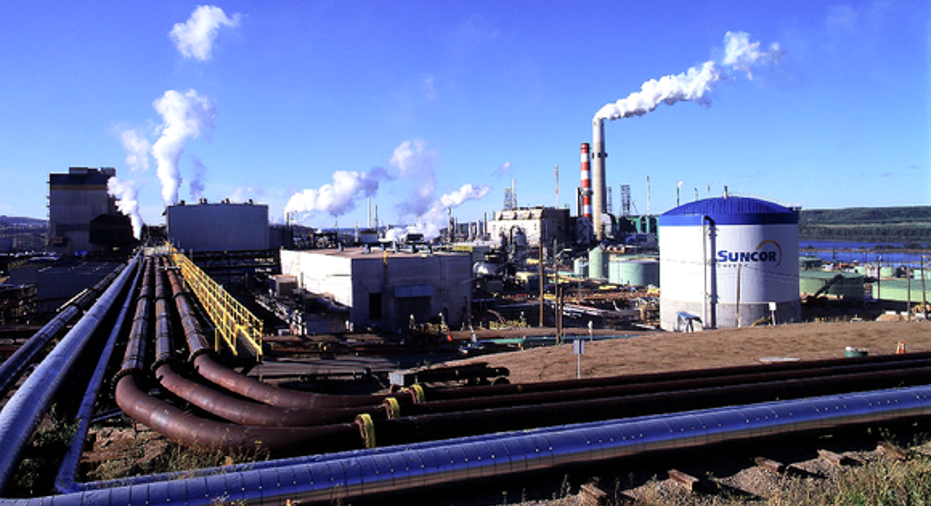Suncor Energy Restarts Oil Sands Production

Image source: Suncor Energy.
Nearly every oil- and gas-producing company has struggled to cope with this year's collapse in oil prices. To add insult to injury, Canadian forest fires caused Suncor Energy to shutter production in its key oil sands operations for over a month. With the recent announcement that its oil sands production will return to normal in June, though, Suncor remains in a good position to maintain long-term profitability. Here's why.
Lost production
Suncor made the prudent decision in early May to shut down production when the massive forest fires in Alberta came within 15 to 20 miles of its base plant operations, opting to evacuate its thousands of workers to safety. The move resulted in the company avoiding any major damage to its facilities and, more importantly, any harm to its employees. By early June, as the fire moved east and favorable weather conditions helped tamp down the flames, Suncor decided it could once again ramp up production.
Suncor is confident that with no damage to its infrastructure, it can quickly reestablish operations. Recent Suncor press releases indicated that it expects oil sands production to return to normal, pre-fire levels by the end of June. Syncrude, a Suncor affiliate that also ceased operations, expects normal production levels by mid-July.
Once Suncor restarts production to its pre-fire levels, Suncor will have essentially lost up to two months of profitable production. The company recently released revised upstream estimates for 2016, trimming its expected production from the original target of between 620,000 barrels per day (bbls/d) and 665,000 bbls/d to 585,000 bbls/d and 620,000 bbls/d.Further, while Suncor expects cash operating costs to remain within $27 to $30 per barrel for 2016, it expects Syncrude's cash operating costs to jump to $41 to $44 per barrel up from $35 to $38 because of restart delays and ramp-up timelines.
Cash flow remains strong
The fires could not have come at a worse time, as weak oil prices limited Suncor's first-quarter cash flows to $682 million, down from $1.5 billion in the first quarter of 2015. Regardless, Suncor maintains a flush war chest of over $3 billion in cash, not including a planned $1 billion to $1.5 billion in divestments this year. On top of that, prior to the fire that suspended operations, first-quarter oil sands cash operating costs per barrel sat at an all time low of $24.25because of cost reductions and an increase in production. Suncor is confident it can return to those cost-effective production levels.
A sizable combination of cash, issuance of equity, and debt has enabled the company to invest approximately $9 billion over the past nine months, increasing production capacity by 164,000 bbls/d. These strategic investments aimed at future growth include the $6.6 billion acquisition of Canadian Oil Sands and an increased stake in the Fort Hills oil sands project, expected to cost around $2.25 billion this year. It further bolstered its investment capability when it recently announced an agreement to sell 71.5 million common shares for $2.5 billion in order to reduce debt and acquire an additional 5% stake in the Syncrude joint venture. Ultimately, Suncor will utilize its cash and investments to show that the lost production was a blip, not a trend.
Investor takeaway
Suncor has shown the capability to reduce the costs of production while adding capacity, meaning it's in a good position to ride out future shocks to the market. With the price of Brent crude steadily increasing to around $50, Suncor has the opportunity to improve its operating profit margins and increase its net earnings. The fires in Canada put a serious damper on oil sands production, but with operations coming back online, Suncor's strong cash reserves and strategic acquisitions make for a favorable long-term outlook.
The article Suncor Energy Restarts Oil Sands Production originally appeared on Fool.com.
David Lettis has no position in any stocks mentioned. The Motley Fool has no position in any of the stocks mentioned. Try any of our Foolish newsletter services free for 30 days. We Fools may not all hold the same opinions, but we all believe that considering a diverse range of insights makes us better investors. The Motley Fool has a disclosure policy.
Copyright 1995 - 2016 The Motley Fool, LLC. All rights reserved. The Motley Fool has a disclosure policy.



















